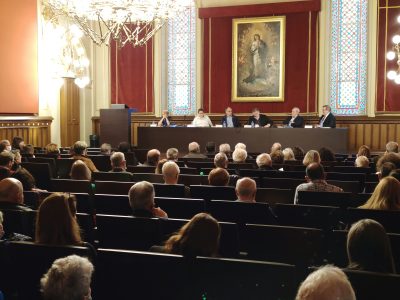
On 21 April, the Centre Tarraconense El Seminari in Tarragona hosted the presentation of the book Sant Fructuós de Tarragona. Aspectes històrics i arqueològics del seu culte, des de l’antiguitat fins a l’actualitat, by Andreu Muñoz Melgar; a study that shed light on the recent development of Christian archaeology in the city of Tarragona.
The book provides a cross and updated view of the history of the martyrs of Tarraco, the archaeological traces they have left behind, and the expansion of their cult over the centuries. The publication is the result of the doctoral thesis that Andreu Muñoz, director of the Diocesan Museums of Tarragona and associate researcher at the ICAC, defended at the ICAC in September 2013.
The event included speeches by Dr. Josep Maria Macias Solé, researcher at the Catalan Institute of Classical Archaeology, ICAC (and who was the director of the thesis of Andreu Muñoz); Dra. Cristina Godoy Fernández, professor of Christian archaeology at the Facultat Antoni Gaudí (AUSP); Dr. Josep Maria Palet Martínez, director of the ICAC, and Dr. Cristina Godoy Fernández, professor of Christian archaeology at the Faculty Antoni Gaudí (AUSP); Dr. Josep Maria Palet Martínez, director of the ICAC; Imma Teixell, president of the Sant Fructuós Cultural Association; and Dr. Armand Puig Tàrrech, rector of the Ateneu Universitari Sant Pacià.
The study Sant Fructuós de Tarragona. Aspectes històrics i arqueològics del seu culte, des de l’antiguitat fins a l’actualitat wants to give an account of the Christian roots in our society; but it also raises, indirectly, many methodological questions: How can the study of the Paleochristian archaeology in our present society be approached nowadays or in the future in a satisfactory way? Will the new generations have enough humanistic and religious training to achieve these scientific challenges?
Muñoz makes a careful and updated analysis of the passio fructuosi, where references to Christian studies and sources have been constant. The author focuses on the context and typology of the document and, above all, analyses the events of the Passion, placing them in the setting of the capital of the province Hispania Citerior, which belonged to the Emperor’s house and was, at that time, the largest in the Empire.
The imprisonment, the trial, and the three executions were not a local event, but a matter of state and imperial scope. The impact of the martyrdom of three people in the Amphitheatre was decisive for the late-antique and medieval history of the city of Tarragona.

The book also deals with the archaeology and urban topography surrounding the cult of the martyrs, both regarding the area within the city walls, basically the Part Alta, and the port suburb around the Francolí river: the necropolis area. It is a journey that begins in the 3rd century AD and ends in the High Middle Ages, reflecting the transcendence of the events that took place in the year 259 up to a thousand years later.
With the cult of Sant Fructuós as the guiding thread, Andreu Muñoz’s work provides a better understanding of the impact of Christianity on the evolution of Roman cities.
Despite the importance of the character in the history of the city, the cult of Sant Fructuós has been religiously and popularly forgotten. In this sense, the book Sant Fructuós de Tarragona. Aspectes històrics i arqueològics del seu culte, des de l’antiguitat fins a l’actualitat also is a valuable contribution as a work of dissemination. Andreu Muñoz has been able to create a piece that, in addition to the scientific and technical rigour that it indicates, is written to reach the general public and bring the character of Sant Fructuós closer to society.
Andreu Muñoz’s dissemination outreach is also noteworthy in the Sant Fructuós Cultural Association, which since 1989 has established the dramatisation of the passion of Sant Fructuós and carries out other activities to spread the character of the martyr and his legacy to the city of Tarragona.
The book Sant Fructuós de Tarragona. Aspectes històrics i arqueològics del seu culte, des de l’antiguitat fins a l’actualitat belongs to the series Studia Archaeologiae Christianae of Sant Pacià Books, which has already released four issues, two of them as joint publications with the ICAC.





